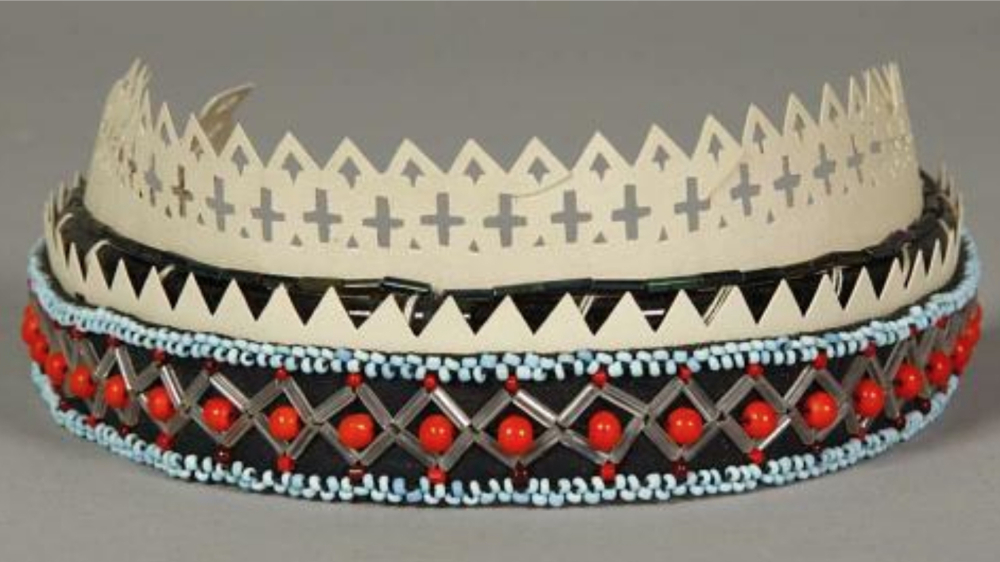I can imagine Frances Densmore as she sat in a train car in 1933. Her luggage and audio recording equipment stowed out of view, she was accompanied by her sister and longtime traveling companion, Margaret Densmore. Over the course of a few weeks, the two had traversed the western reaches of the American South, arriving first in east Texas, then southern Louisiana, and finally on to central Mississippi. By that time, Frances Densmore was well practiced in speaking to and recording the songs and voices of Native American singers and knowledge holders. Having studied music at Oberlin College as a young woman, for years she had been conducting research in connection with the Smithsonian Institute’s Bureau of American Ethnology. Her expansive work with the Native peoples of Minnesota and the Dakotas served primarily as the basis for her scholarly fame as one of America’s first female professional ethnographers and ethnomusicologists.
This trip, however, was different. It was one of her few trips to the South—perhaps her only one to Mississippi. She had met Alabama-Coushatta and Chitimacha community members in search of a particular “period formation” in their music traditions, and on this leg of the journey she hoped to carry out the same research on Choctaw songs. 1 Traveling north from New Orleans, she and her sister stopped and spent the night of January 12th in the city of Laurel. They stayed at the grand Hotel Pinehurst, a detail Densmore jotted in tiny script into her pocket-sized, leather bound diary. After arriving in Philadelphia, they sought out the aid of then-Choctaw Agency Superintendent A. C. Hector, likely in hopes that he would introduce them to some Choctaw community members who might consider performing their songs for her. I wonder what she thought of Philadelphia, the agency, and what, exactly, she expected to find there.
Considering Frances Densmore’s brief visit with Choctaw community members provides an example for thinking more critically about history and about whose voices are included in it.
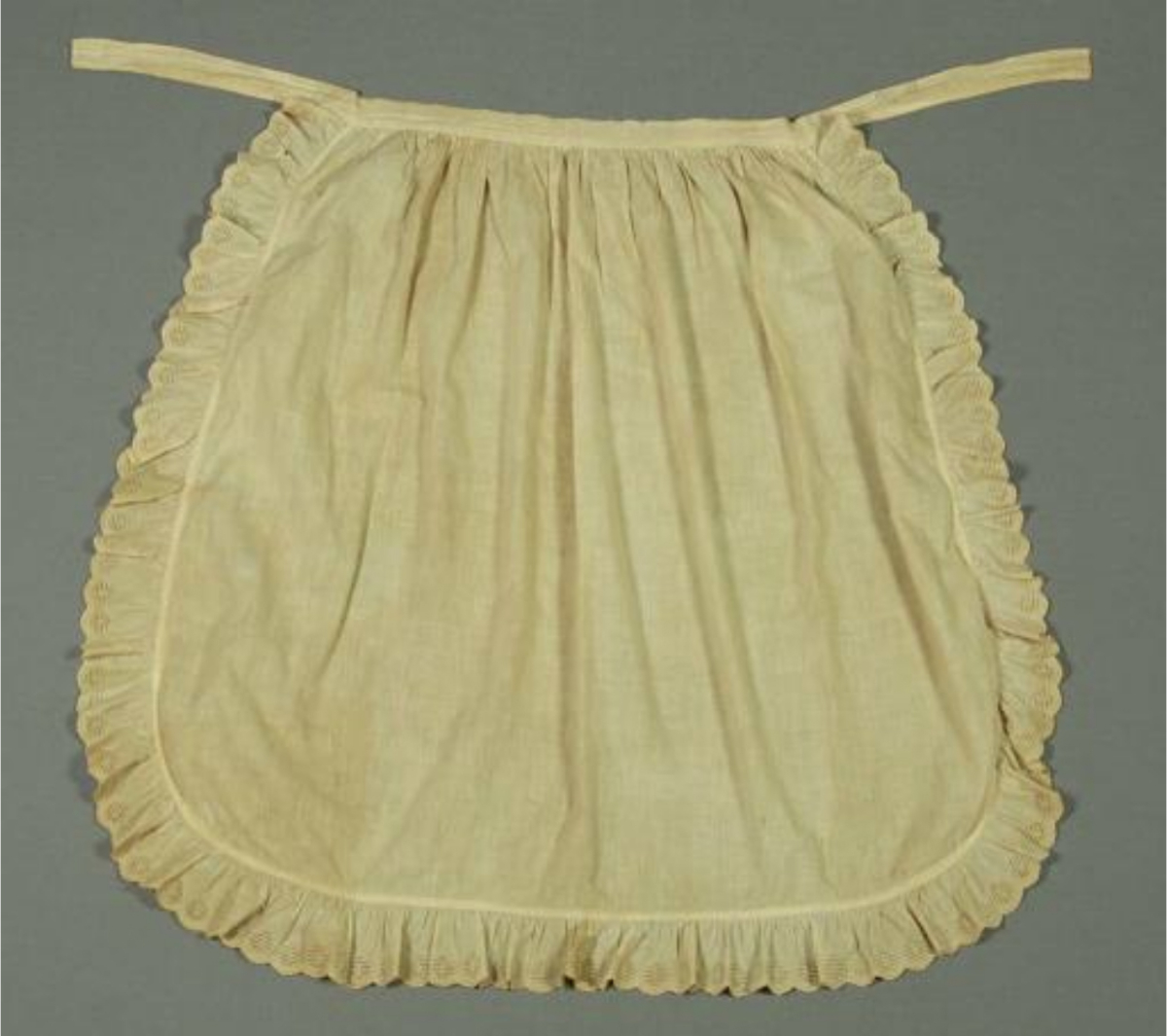
Likely following Hector’s lead, she spent nearly two weeks meeting with people in the Choctaw communities of Tucker, Pearl River, and Bogue Chitto. She filled the pages of her notebook with the songs and words of Sidney Wesley; Mary Hickman, Sidney Wesley’s neighbor in Tucker; Lysander Tubby; Robert Henry; and Gus Willis. She photographed Sidney Wesley, taking note of his distinctive, long white hair. Lysander Tubby, she learned, was a singer in one of his community’s dance groups, as was Gus Willis. Robert Henry, on the other hand, was particularly knowledgeable about the ceremonial aspects of Choctaw stickball games. 2
As the days passed, Densmore asked the men to recall and sing the oldest songs they knew. They performed the Quail Dance Song, the Terrapin Song, the Hunting Song, and the Rabbit in the Garden Song into her recorder. Olman Comby, a Choctaw “policeman at the agency” 3 , must have been working hard in his role as her interpreter, translating Choctaw ways of knowing into English ones. He also shared some songs with her. I wonder what Mr. Comby and the other singers made of Densmore, her questions, and her recorder.
Mr. Henry talked at length with Densmore about the importance of the stickball game, and all the strategies and practices carried out by community members to ensure a player or a team’s success. She carefully reproduced the snake design etched onto one of his flutes, as well as Mr. Henry’s “personal symbol” that adorned another. Looking at this week through Densmore’s eyes, I think that perhaps Mr. Henry showed her that she needed to understand stickball in order to understand some facets of Choctaw music. She photographed Mr. Henry with a stickball stick pair, and a group of men played a short game for her as well. She left Bogue Chitto that day carrying her own pair of stickball sticks and a ball.
Likewise, as was common in this period, Densmore also potentially chose to use the language of objectivity at the expense of her own voice.
Densmore also came to learn that understanding Choctaw social dancing is another central element to understanding Choctaw music. She attended such an event at Pearl River on the evening of January 21st. One of the dance’s song leaders was Lysander Tubby. She watched the dancers’ movements as they carefully stepped and turned their way through the Stealing Partners Dance and the Snake Dance. 4 Who were these dancers? And were they performing only for Densmore’s benefit?
Satisfied in finding the musical patterns she was looking for—and perhaps also exhausting the time her Choctaw acquaintances were willing and able to give to her—she and Margaret packed their bags, notes, and recordings and departed Mississippi by train on February 1st or 2nd. The findings of this particular trip Densmore would use to write “Choctaw Music,” a paper published by the Bureau of American Ethnology in 1943. She included several photos in this document, likely only a selection of the ones she had taken. She chose her portrait of Sidney Wesley, his white hair falling at his shoulders; and one of his neighbor, Mary Hickman, her head wrapped in a kerchief. Densmore also included her portraits of Lysander Tubby and Olman Comby: Mr. Tubby stands with his hands in his pockets, wearing boots, a coat, and a hat, perhaps to ward off the winter chill, while Mr. Comby wears a dark three-piece suit, his close cropped hair neatly combed and parted to the left. The plates of “Choctaw Music” were also filled with photos of Robert Henry and his family and friends at Bogue Chitto, including one of Mr. Henry’s house, and an image of the stickball game that they had generously put on for Densmore.
But the photos she chose of her visit with Choctaw community members suggest a larger story than the one she presented to her readers. The plates in her article also include images of Choctaw women and girls, as well as photos of precious pieces of their personal adornment, many of which now live in the Smithsonian Institution’s National Museum of Natural History in Washington, DC. Who were these women, and why were their stories absent from Desnmore’s notes and her published account? What did they speak about, and what did she learn from them? As a scholar and seasoned ethnographer, Densmore was by this time well practiced in recording and documenting the world around her, and in thinking critically and analytically about that world. Where were these women’s voices in her writing? In order to more fully shine some light on these Choctaw women, I will now focus on the belongings that Densmore collected to explore the life and material realities of one of the only two women Densmore named in her account, Maggie Billie.
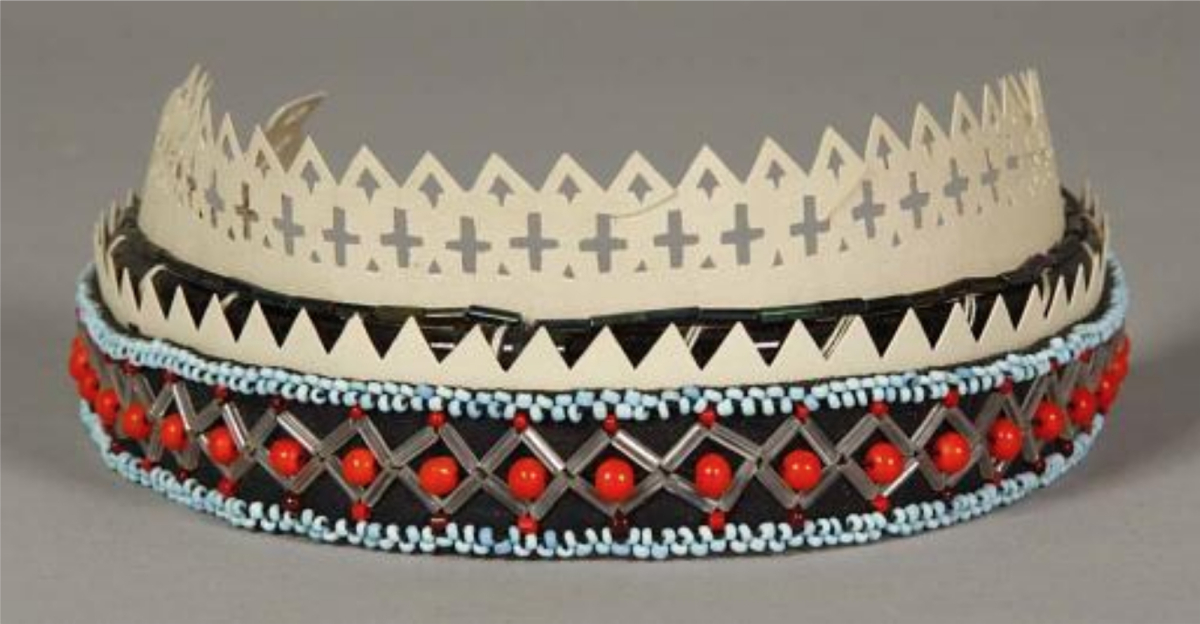
According to US census records, Maggie Billie was born between 1907 and 1909 to Wade and Bettie Billie. In 1920, she was one of four children, and her father worked as a farmer in Neshoba County. By 1930, she was listed as the head of her household, renting her own lodging near Old Philadelphia and Mendian Road and working as a farmer. Sadly, by that time she was also widowed at a very young age. 5 Three years later, she encountered Frances Densmore, who took her photo in front of a storefront window, probably in Philadelphia or maybe Pearl River. That day in January of 1933, she smiled slightly and wore her dark hair tied back, held in place in part by a beaded roundcomb placed over the crown of her head and above her ears. Around her neck, she had draped several strands of beaded necklaces, and wore a patterned, handmade, light colored cotton Choctaw dress with a coordinating white apron. On her fingers she chose to wear silver rings and adorned her right arm with a silver bracelet.
In “Choctaw Music,” Densmore describes Ms. Billie only very briefly:
“Maggie Billie (pl 12, fig.1) is an expert basket maker, and wears this costume when she comes to town. Her dress, apron, woven bead collar, and fancy comb are shown in plates 12 and 13. The latter is made from an ordinary ‘round comb’; the white ornament is cut from a man’s celluloid collar and the beadwork is on a stiffened band of dark cloth.” 6
Unfortunately, this is all Densmore shares about Ms. Billie. How did they meet? What did they talk about? Was Ms. Billie related to the girls in Densmore’s other photographs? Densmore’s field note on January 14th, 1933, indicates that she “[bought] baskets” and spent the “evening at Pearl River,” suggesting that the two women met when Densmore was buying baskets. Perhaps Ms. Billie had come to town that day to sell her some of her weavings, or maybe she had come to purchase or trade for supplies at one of the larger town stores. It is also possible that she was related to one of the men who Densmore records singing, or that Ms. Billie was a part of the same dance group as Lysander Tubby.
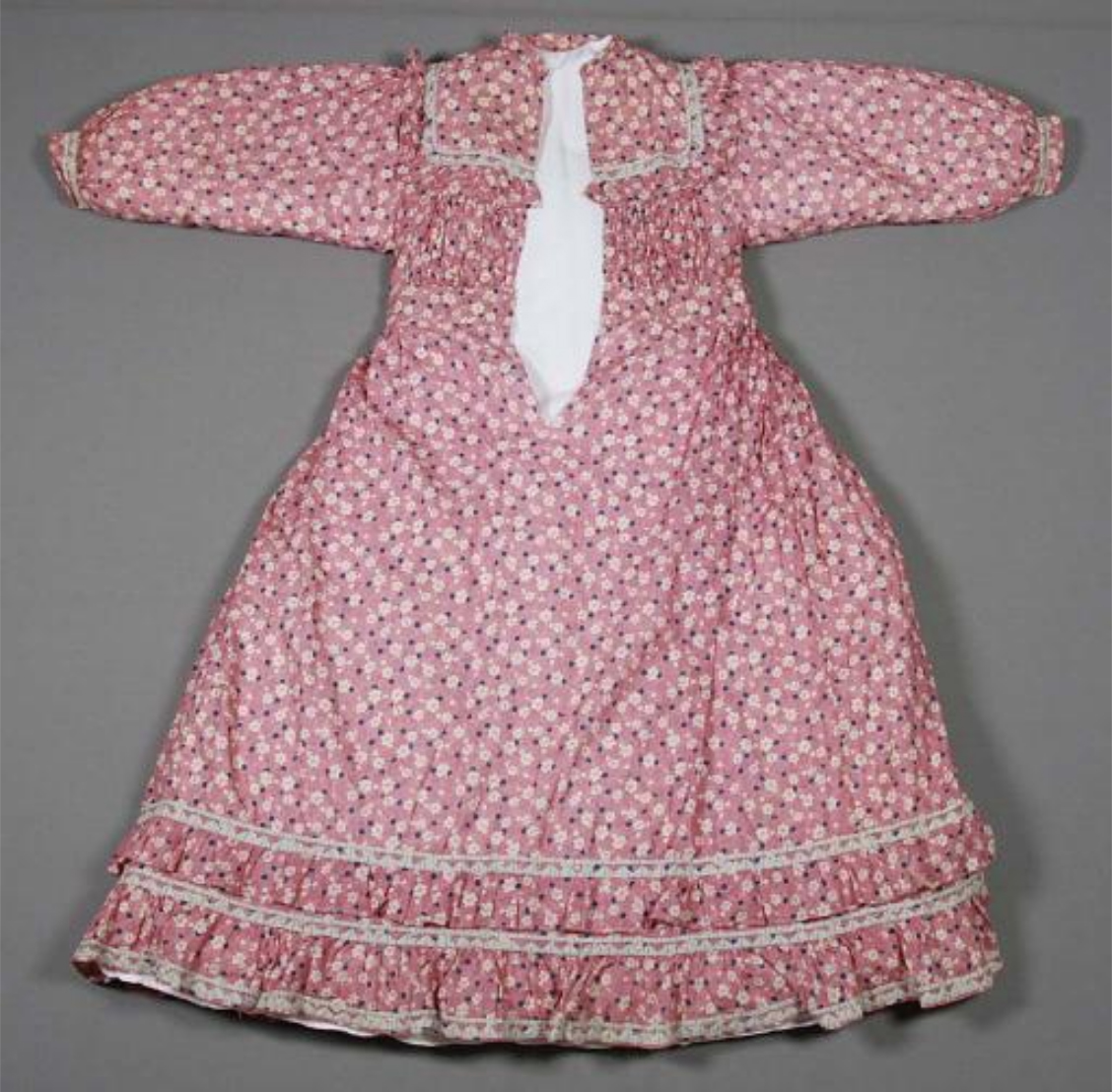
The brevity of Densmore’s discussion of Maggie Billie belies the very personal nature of the items she collected from her. One was a finely constructed, rather formal dress and apron set. Made of pink cotton, printed with white and blue flowers, the dress was carefully decorated with layers of ruffles and was hand appliqued with a white half-diamond motif. The entire garment was meticulously and lovingly sewn with thousands of tiny, handmade stitches. The dress’s matching apron was constructed of plain white cotton, but its gathered ruffle was made from a fine, delicate lace-like material. Frances Densmore wrote that these garments were made only a year before, in 1932. Did Maggie Billie make them? Or were they sewn by some of her relatives? And why did she part with something so new, so precious, and so time consuming to make?
I hope that revisiting this important article will encourage readers to think of other silences that might be present in their own histories, and how to work to bring those stories back into focus.
Ms. Billie also provided Densmore with beadwork—in fact, she made a nearly complete formal outfit available to her. She showed Densmore a small beaded collar necklace, an intricate latticework of transparent green bugle beads and round red beads. Maggie Billie and other Choctaw women would have worn a necklace like this draped around their shoulders, clasped at the back. Similar beads appear on the decoration of the round comb that Ms. Billie presented, its lower black band covered in a diamond pattern formed by tiny blue seed beads, clear bugle beads, and round red beads. In many ways, this pattern echoes the half diamond motif present on the dress’ applique. Like the one Ms. Billie wears in Densmore’s photo of her, the comb’s delicate celluloid top is carefully incised. Its maker had painstakingly carved a rather readily available, mundane men’s item—a plastic, rigid shirt collar—until it was transformed into something remarkable, an intricate pattern of repeating cross shapes, crowned by a row of perfectly symmetrical points.
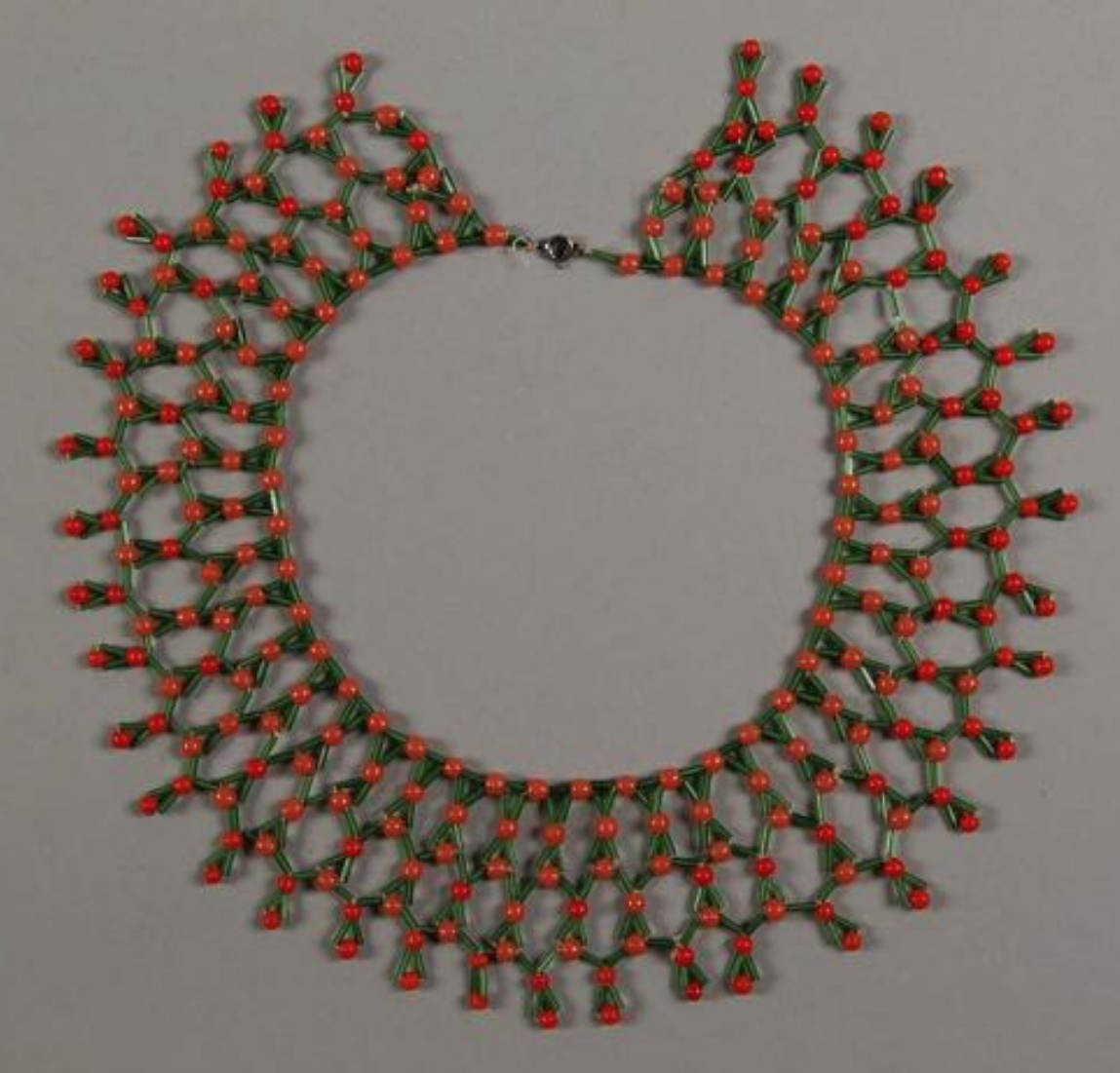
While Frances Densmore did not record Maggie Billie’s thoughts about these belongings, or what they might mean to her and to her community, the care and skill that their makers used to construct them speaks volumes about their importance. They represent the hands and the artistic and aesthetic visions of their makers made manifest. The new dress, apron, and handmade jewelry signals that Choctaw women were continually making, wearing, and exchanging these arts, both among themselves and with those outside of their community. These women were present in Densmore’s exchange, whether she noted them or not. Embedded in the tiny dress stitches, and in the carvings in the celluloid collar, are the physical manifestations of the voices of these women and of their makers. Choctaw sewers and beaders continue to make these clothing and objects of personal adornment today, connecting Maggie Billie, her belongings, and the other subjects of Densmore’s photos to a vast network of women.
Embedded in the tiny dress stitches, and in the carvings in the celluloid collar, are the physical manifestations of the voices of these women and of their makers.
Considering Frances Densmore’s brief visit with Choctaw community members provides an example for thinking more critically about history and about whose voices are included in it. While Densmore’s publication, “Choctaw Music,” provides important information on the musical practices of a Native nation from a period of their history that was largely neglected by scholars, the totality of her experience with the Choctaw community is absent from her text and absent even from her notes. Why was Densmore collecting Maggie Billie’s belongings, while also making the decision not to write about her? Did she encounter any female singers or stickball players—if she did not, why did this not receive further analysis?
While many have written about Frances Densmore’s work—as well as her complicated legacy 7 —in her writing, Densmore’s voice is muted. Her text is brief, declarative, and authoritative, much like the bars of music that she extracted from the voices of Sidney Wesley, Lysander Tubby, Robert Henry, and Gus Willis, as they sang the songs they learned from their fathers, uncles, and grandfathers. As they sang the songs that would have brought the dance grounds and stickball fields to life. Densmore’s focus was not on communicating this richness, but rather it was on summarizing and abstracting these songs. She did so, likely unintentionally, at the expense of the voices of her female Choctaw acquaintances.
Likewise, as was common in this period, Densmore also potentially chose to use the language of objectivity at the expense of her own voice. Her personal perspective and positionality as a single female scholar working in a time dominated by white male scholarship, and her own perspective as a person just arrived in a new place, is difficult to find. Was she concerned that her peers did not consider women’s voices worthy of study, and therefore that they would not value or support such work if she were to take it on? While I cannot answer these questions, I hope that revisiting this important article will encourage readers to think of other silences that might be present in their own histories, and how to work to bring those stories back into focus.
Inspiration from this article was taken from my visit to Frances Densmore’s Mississippi fieldnotes, now held in Washington, DC: “Papers of Frances Densmore,” MS 4250, Folders 1-6, National Anthropological Archives, Smithsonian Institution.
I also relied on visual analyses of objects E380093, E380094, E380095, E380096, now housed in the Anthropology Department of the National Museum of Natural History, Smithsonian Institution, Washington DC. Special thanks goes to this department for giving Mississippi Folklife permission to reproduce their images of these objects.
If any readers know more about Maggie Billie or the other women featured in “Choctaw Music,” please contact Mississippi Folklife’s Customs Editor at msfolklifeeditor@gmail.com .
Resources
Densmore, Frances. “Choctaw Music.” Bureau of American Ethnology Bulletin 136. Washington DC: Government Printing Office, 1943.
Jensen, Joan M., and Michelle Wick Patterson. Travels with Frances Densmore: Her Life, Work, and Legacy in Native American Studies. Lincoln: University of Nebraska Press, 2015.
Links
United States of America Bureau of the Census. “Fifteenth Census of the United States, 1930, Philadelphia, Neshoba, Mississippi,” 1930. Enumaration District 0005,. ancestry.com.
———. “Fourteenth Census of the United States, 1920, Tucker, Neshoba, Mississippi,” 1920. Enumaration District 0080. ancestry.com.
Footnotes
- ^ Densmore, Choctaw Music, 118.
- ^ Densmore, 111.
- ^ Densmore, 112.
- ^ Densmore, 135.
- ^ This information comes from the United States of America Bureau of the Census, “Fourteenth Census of the United States, 1920, Tucker, Neshoba, Mississippi,” 20; United States of America Bureau of the Census, “Fifteenth Census of the United States, 1930, Philadelphia, Neshoba, Mississippi,” 13B.
- ^ Densmore, Choctaw Music, 116.
- ^ See for one thorough and recent example, Jensen and Patterson, Travels with Frances Densmore.

